The AI Revolution's Double-Edged Sword: Balancing Innovation and User-Centric Design in 2025
As we stand at the intersection of technological innovation and human-centered design in 2025, the artificial intelligence revolution continues to reshape our world in unprecedented ways. This transformative era brings both extraordinary opportunities and significant challenges that demand our attention and thoughtful consideration.

The Current State of AI Integration
The integration of AI into our daily lives has reached new heights in 2025, fundamentally altering how we interact with technology. From sophisticated natural language processing to advanced machine learning algorithms, AI has become an integral part of user experience design. However, this integration presents a complex dichotomy that organizations must carefully navigate.
Opportunities in Innovation
The AI revolution has ushered in remarkable advantages for both businesses and users:
- Enhanced Personalization: AI systems now deliver highly customized experiences by analyzing user behavior patterns and preferences with unprecedented accuracy.
- Automated Intelligence: Routine tasks have been streamlined through intelligent automation, allowing humans to focus on more creative and strategic endeavors.
- Predictive Design: AI-powered tools can anticipate user needs and adapt interfaces in real-time, creating more intuitive and responsive experiences.

The Human Element: Maintaining User-Centricity
While AI capabilities continue to expand, maintaining a human-centered approach remains crucial. The challenge lies in leveraging AI's power while ensuring technology serves human needs rather than the other way around.
Key Considerations for User-Centric AI Design
Transparency and Trust
- Clear communication about AI involvement in user interactions
- Explainable AI systems that users can understand and trust
- Visible opt-out options for AI-driven features
Ethical Implementation
- Privacy protection and data security measures
- Bias detection and mitigation in AI algorithms
- Inclusive design practices that consider diverse user groups
Balance of Automation and Human Touch
- Strategic integration of AI while maintaining meaningful human interactions
- Preservation of user agency and control
- Emotional intelligence in AI-human interactions
Addressing Current Challenges
The path to successful AI integration isn't without obstacles. Organizations must address several key challenges:
Privacy and Security Concerns
As AI systems become more sophisticated, protecting user data and maintaining privacy has become increasingly complex. Companies must implement robust security measures while being transparent about data usage.
Ethical Considerations
The ethical implications of AI implementation continue to evolve. Organizations must establish clear guidelines and frameworks for responsible AI development and deployment.

Best Practices for 2025 and Beyond
To successfully navigate the AI revolution while maintaining user-centricity, organizations should:
Implement Ethical AI Frameworks
- Establish clear guidelines for AI development and deployment
- Regular assessment of AI impact on user experience
- Continuous monitoring for bias and fairness
Invest in Human-AI Collaboration
- Train teams in both AI capabilities and human-centered design
- Create balanced workflows that leverage both human and AI strengths
- Regular evaluation of AI effectiveness in enhancing user experience
Maintain Transparent Communication
- Clear disclosure of AI use in products and services
- Regular updates to users about AI-driven features
- Open channels for user feedback and concerns
Future Outlook
As we progress through 2025, the convergence of AI and user-centric design continues to evolve. The key to success lies in finding the right balance between technological advancement and human needs. Organizations that can effectively navigate this balance while maintaining ethical standards will lead the way in creating meaningful and valuable user experiences.
A Call to Action for Continuous Learning
The rapidly evolving landscape of AI and user experience design demands continuous learning and adaptation. To stay ahead of the curve and develop the skills needed for this dynamic field, explore the comprehensive courses and resources available at 01TEK. Our cutting-edge curriculum combines technical expertise with human-centered design principles, preparing you for the challenges and opportunities of tomorrow's digital landscape.
Discover your potential in AI and UX design at 01TEK →
Sources: 1. UX Design Leadership and AI Future 2. UNESCO AI Ethics Guidelines 3. Future of Design Leadership 4. Tech Ethics Lab Research 5. AI-Driven UX Design
Cannibals prefer those who have no spines.
Stanislaw Lem



